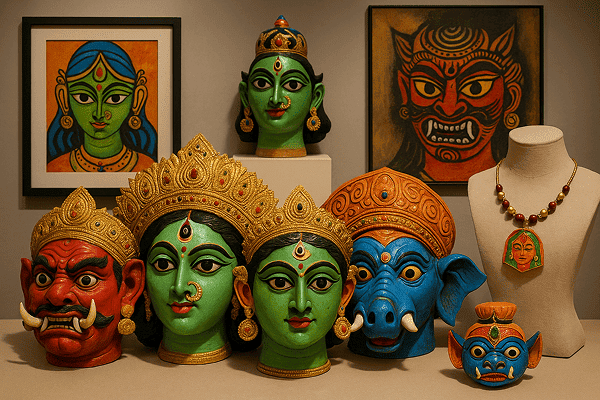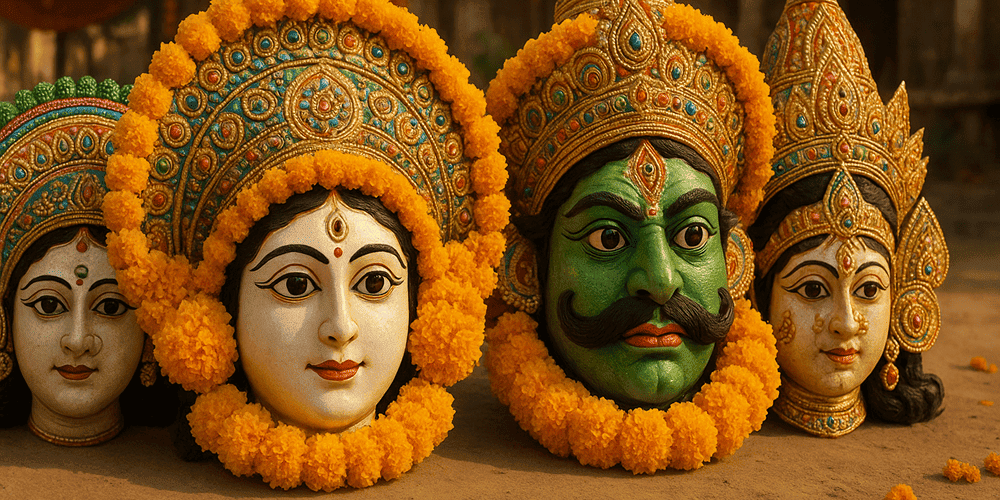Chhau Masks are among the most vivid and culturally significant traditional masks of India, celebrated for their dramatic artistry and deep spiritual resonance. Originating in the eastern states of West Bengal, Jharkhand, and Odisha, Chhau Masks are integral to the vibrant dance-drama tradition known as Chhau. These masks are instantly recognizable for their bold, expressive features, elaborate ornamentation, and eye-catching colors. Typically crafted from papier-mâché or clay, Chhau Masks are adorned with intricate designs — peacock feathers, sequins, and natural pigments — reflecting the mythological and heroic characters they represent. Their origins date back several centuries, closely linked to the folk and ritualistic heritage of Eastern India.
Historical Origins
The history of Chhau Masks is intertwined with the evolution of Chhau dance itself, which is believed to have originated in the 18th century. The term “Chhau” is thought to derive from the Sanskrit “Chhaya,” meaning shadow or mask, or from the Odia word “Chhauni,” referring to a military camp — highlighting the martial origins of the dance. Chhau developed in royal courts and rural communities, blending indigenous martial arts, folk traditions, and classical Indian dance forms.
Early Chhau performances were simple, with minimal costumes and masks. Over time, as the art form received royal patronage and spread across regions, the masks became more elaborate and distinctive. Historical records, temple carvings, and oral traditions from areas like Purulia (West Bengal), Seraikela (Jharkhand), and Mayurbhanj (Odisha) document the gradual evolution of design and function. Notably, Chhau Masks from Purulia are known for their grandeur and size, while Seraikela and Mayurbhanj styles tend to be subtler and often maskless.
Cultural Significance and Symbolism
Chhau Masks are much more than decorative objects; they are imbued with powerful symbolic meaning. Each mask embodies a specific deity, demon, animal, or legendary hero, serving as a vehicle for spiritual transformation during performance. In Hindu culture, the act of wearing a mask is believed to invoke the divine presence, allowing performers to channel gods and mythic beings.

Ritually, Chhau Masks are central to village festivals, especially during the spring festival of Chaitra Parva, dedicated to local deities. The performances act as a medium for communal storytelling, spiritual purification, and social cohesion. Myths from the Mahabharata, Ramayana, and Puranas are dramatized, reinforcing moral values and cultural memory. Socially, these masks unify communities, allowing participants to transcend individual identity and become part of a collective spiritual experience.
Materials and Craftsmanship
The process of making Chhau Masks is a revered folk art, often passed down through generations of master craftsmen. Traditional masks are made primarily from layers of soft papier-mâché, sometimes reinforced with clay, cloth, and natural adhesives. Artisans begin by molding the basic shape over a clay or wooden form, then apply layers of paper soaked in glue, which are left to dry and harden.
Once shaped, the mask is carefully carved, sanded, and painted with vivid colors — red, green, blue, yellow — each chosen for its symbolic value. Decorative elements such as sequins, mirrors, metallic foils, feathers, and colored threads are meticulously added. The eyes, eyebrows, and mouth are accentuated to maximize dramatic effect on stage. Regional variations influence both style and materials: Purulia masks are large and flamboyant, often with towering headpieces, while Seraikela masks are smaller, more restrained, and subtle in expression.
Color symbolism is crucial: red often denotes valor or anger, green can symbolize fertility and new life, blue is linked to Krishna and the divine, and gold highlights divinity or royalty. This meticulous craftsmanship ensures each mask is a unique work of art, suited to its character’s role in Chhau narratives.
Functions and Usage
Chhau Masks are primarily used in the ritual and theatrical context of Chhau dance-dramas. These performances are the highlight of religious festivals, village fairs, and temple celebrations, where stories from Hindu epics and local legends are enacted. The dancer, concealed behind the mask, uses stylized movements to express emotion, spiritual transformation, and narrative action.
Beyond their ceremonial function, Chhau Masks are also displayed in processions, community rituals, and educational exhibitions. While traditional use centered on rural religious observances, the masks and dances have gained national and international recognition, leading to performances at prestigious festivals and cultural exchanges. In recent decades, Chhau Masks have also been collected as folk art, exhibited in museums, and adapted for contemporary artistic expression.
Regional Variations
Chhau Masks display a remarkable diversity across the three main regional styles:
- Purulia Chhau (West Bengal): Known for their large size, flamboyant designs, and dramatic color schemes. Masks depict gods, demons, animals, and even fantastical creatures, with elaborate headgear and facial ornamentation.
- Seraikela Chhau (Jharkhand): Characterized by smaller, subtler masks with refined features. Seraikela performances place emphasis on gesture and subtle facial movement.
- Mayurbhanj Chhau (Odisha): Traditionally performed without masks, focusing instead on expressive body movement and dance.
Unique local features, such as the use of peacock feathers or region-specific mythological characters, distinguish each tradition. When compared to similar Indian traditions like Kathakali Masks from Kerala, Chhau Masks are lighter, more portable, and designed for vigorous dance, while Kathakali Masks are heavier and more intricate, intended for classical drama.
Notable Examples and Collections
Outstanding examples of Chhau Masks can be found in several renowned collections and institutions:
- Indian Museum (Kolkata): Holds historic Purulia Chhau Masks and documents the evolution of the craft.
- National Crafts Museum (New Delhi): Features regional mask varieties and showcases the work of master artisans.
- Victoria and Albert Museum (London): Includes examples in their South Asian folk art collection.
- Local museums in Purulia, Seraikela, and Baripada: Display traditional masks and tools used in their creation.
Private collections and online platforms such as toddmasks.com provide additional access to both antique and contemporary Chhau Masks, helping to preserve and share this unique tradition with a global audience.
Influence on Art and Culture
Chhau Masks have had a profound impact on Indian visual and performing arts. Their bold forms and vibrant colors have inspired painters, sculptors, and fashion designers. The masks are frequently featured in literature, films, and documentaries exploring Indian folklore and rural life. Contemporary artists incorporate Chhau motifs in modern installations and stage design, while fashion houses use mask imagery in jewelry and textiles.

The masks also play a crucial role in preserving oral traditions and folk narratives, ensuring that ancient stories and values remain accessible to new generations. Their influence can be compared to that of Kathakali Masks, which similarly bridge the worlds of ritual, performance, and visual culture in India.
Contemporary Status and Preservation
Today, the art of Chhau Mask-making is sustained by dedicated communities of artisans, often centered in the villages of Charida (Purulia) and Seraikela. Government support, UNESCO recognition (Purulia Chhau dance as Intangible Cultural Heritage), and cultural organizations have bolstered efforts to document and teach the craft. Modern workshops, master classes, and school programs introduce new generations to mask-making and Chhau performance.
Innovations include the use of contemporary materials, eco-friendly paints, and new narrative themes, ensuring the tradition remains relevant. Educational outreach, exhibitions, and festivals — both in India and abroad — contribute to the ongoing vitality of the craft. Online resources like toddmasks.com play a significant role in raising awareness and connecting collectors, artists, and scholars worldwide.
Collecting and Acquisition
The market for Chhau Masks spans from affordable festival souvenirs to highly prized art pieces crafted by acclaimed artisans. Authentic masks can be purchased directly from workshops in Purulia or Seraikela, through museum shops, and at folk art fairs. Online galleries and reputable dealers, including toddmasks.com, offer a wide selection for collectors.
Prices depend on age, artistry, provenance, and condition. Antique or ceremonial masks with documented history command the highest values, while contemporary pieces by master craftsmen are also highly sought after. When acquiring Chhau Masks, buyers are encouraged to seek provenance, support fair trade practices, and respect cultural significance.
